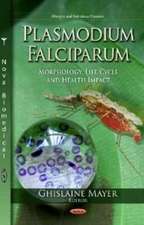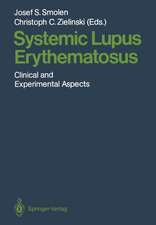New Trends in Allergy III
Editat de Johannes Ring Cuvânt înainte de O. Braun-Falco Editat de Bernhard Przybillaen Limba Engleză Paperback – 14 mar 2012
Preț: 732.56 lei
Preț vechi: 771.12 lei
-5% Nou
Puncte Express: 1099
Preț estimativ în valută:
140.18€ • 144.84$ • 116.61£
140.18€ • 144.84$ • 116.61£
Carte tipărită la comandă
Livrare economică 20 martie-03 aprilie
Preluare comenzi: 021 569.72.76
Specificații
ISBN-13: 9783642467196
ISBN-10: 3642467199
Pagini: 604
Ilustrații: XXV, 575 p.
Dimensiuni: 155 x 235 x 32 mm
Greutate: 0.84 kg
Ediția:Softcover reprint of the original 1st ed. 1991
Editura: Springer Berlin, Heidelberg
Colecția Springer
Locul publicării:Berlin, Heidelberg, Germany
ISBN-10: 3642467199
Pagini: 604
Ilustrații: XXV, 575 p.
Dimensiuni: 155 x 235 x 32 mm
Greutate: 0.84 kg
Ediția:Softcover reprint of the original 1st ed. 1991
Editura: Springer Berlin, Heidelberg
Colecția Springer
Locul publicării:Berlin, Heidelberg, Germany
Public țintă
ResearchDescriere
The international symposium "New Trends in Allergy", held in Munich from July 13 to 15, 1990, brought together for the third time since 1980 some of the most experienced researchers working in the field of allergy. This volume comprises the papers presented at this meeting. All over the world, and not merely in the industrialized countries, allergy is becoming a cause of evermore serious diseases. In recent years, research in the field of allergy has provided numerous impor tant and fascinating results extending our knowledge considerably. Despite the new insights into basic mechanisms of allergic reactions, improved diagnostic methods, and new therapeutic approaches, how ever, many questions remain to be answered, including: Are allergies really increasing in frequency? If so, what are the reasons? Especially, does environmental pollution playa role? Which factors influence IgE synthesis? Can the IgE immune response be switched off? Does the nervous system interact with allergic reactions? If so, what are the mechanisms? Are new approaches in allergy prophylaxis and allergy therapy effi cient? What measures have proven useful and deserve to be employed in daily practice? In this volume, these questions and other current topics are dealt with. As each issue is covered by authors competent in the respective fields, the result is an extensive and critical review of the state of the art. Going through these papers, one comes to the conviction that allergy research is a multifacetted, explosively expanding, most stimulating field of work.
Cuprins
Epidemiology.- Are Allergies Increasing?.- Epidemiology of Various Allergic Reactions.- Epidemiology of Contact Allergy.- Allergens.- Epitopes on Allergens.- Cloning of Birch Pollen Allergens.- Molecular Structure of Allergens.- Characterization of Antigens and Allergens of Bird Feathers and Bird Sera.- Hop Allergy: Cross-Reactivity to Birch Pollen.- Immunoglobulin E Response.- Possible Approaches to Controlling the IgE Antibody Response.- Human Fc?RII/CD23 in the Regulation of the Allergic Immune Response.- Inbred Strains of Guinea Pigs in Studies of Allergy.- Multispecific Allergic Reactions.- Loss of Fc?R2/CD23 Expression on T and B Lymphocytes During Rush Hyposensitization.- Construction of Human Suppressor T Cell Hybridomas That Produce Glycosylation Inhibiting Factors from Peripheral Blood Mononuclear Cells of Bee Venom Sensitive Patients.- Anti-IgE Autoantibodies Hide Specific IgE and Are Mistaken for Specific IgG.- Mast Cells and Mediator Release.- In Vitro Growth of Human Mast Cells and Their Functions.- Mast Cells and Fibroblasts: Partners or Neighbors?.- Factors Promoting Histamine and Leukotriene Release.- Cyclosporin A Inhibits IgE Receptor Mediated Exocytosis from Rat Basophilic Leukemia Cells Without Inhibiting Phosphatidylinositol Hydrolysis, Ca2+ Uptake, the Rise in Cytosolic Ca2+ Actin Polymerization or Arachidonic Acid Release.- Prostaglandin D Synthetase is Localized in Antigen Presenting Cells and Mast Cells.- Influence of Histamine H1, H2, and H3 Agonists and Antagonists on IgE Mediated Histamine Release from Human Basophils.- Impact of Biophysical Plasma Membrane Properties on Leukocyte/Endothelium Interaction.- Interleukin-3 and Granulocyte/Macrophage Colony-Stimulating Factor Change the Anaphylatoxin-Induced Basophil Mediator Release Pattern.- Neuropeptides and Human Mast Cells.- Neuronal Interaction with Mast Cells.- Atopic Eczema.- T Cells in Atopic Dermatitis.- IgE Receptor Expression on Langerhans Cells.- Contact Sensitivity to Pityrosporum ovale in Patients with Atopic Dermatitis.- Irritable Skin in Atopic Eczema.- Stigmata and Signs of Atopic Eczema.- Patch Test with Immediate Type Allergens in Patients with Atopic Dermatitis.- Chronobiological Aspects of Atopic Disease.- Food Allergy.- On the Diagnosis of Food Allergy in Adults — A Comparison Between DBPCFC and Intragastric Provocations.- Gastric Reactivity to Flour Extracts and Helicobacter pylori Associated Gastritis in Patients with Flour Allergy.- Immediate Contact Allergy to Foods: Skin Test Based on Contact Urticaria and IgE Tests in Children with Atopic Dermatitis.- The Prevalence of Food Allergy in Children with Atopic Dermatitis.- Computer System of Medical Information (KSIMPA) — Useful for an Allergological Outpatient Clinic.- Drug Reactions.- Drug Metabolism and Drug Allergy.- Adverse Reactions to Quinolones.- Drug Induced Photosensitivity.- Angiotensin Peptides and Anaphylaxis.- Granulocyte Mediator Release in Pseudo-allergic Reactions.- Photocontact Dermatitis and Persistent Light Reaction from Olaquindox in Piglet Feed.- Hyposensitization.- Allergoids for Hyposensitization.- Hymenoptera Venom Allergy.- Safety of Hyposensitization.- Trends in the Use of Specific Immunotherapy.- Autoimmune Diseases.- Autoantibodies Provide Insights into Antigens Driving Autoimmunity.- The Diagnostic Significance of Antinuclear Antibodies.- The Anticardiolipin Syndrome — A Clinical Study.- Antibodies to Basement Membrane Antigens.- Contact Dermatitis.- Genetics of Contact Allergy.- Atopy and Contact Allergy.- Neutrophil-Activating Peptide 1/Interleukin 8.- A Simple Method to Determine Permeation Resistance of Polymer Gloves.- Age Dependence and Regional Anatomical Variability of Cutaneous Irritation.- Immediate-Type Reactions to Rubber Products: IgE Mediated?.- Mite Allergy.- The Storage Mite Story.- House Dust Mites in German Homes.- House Dust Mites and Protective Measures — A Study on Solidified Benzyl Benzoate.- Environmental Pollution and Allergy.- Environment and Allergy.- Allergens and Pollutants in the Air — A Complex Interaction.- Platinum Salt Asthma.- Induction of Mediator Generation in Human Inflammatory Cells by Polychlorinated Biphenyls.- The “Clinical Ecology Syndrome” (“Eco-Syndrome”): Psychology or Allergy?.- Prophylaxis and Therapy.- Eicosanoid Metabolism and Antiallergic Strategies.- Development of New Antiasthmatic Drugs from Traditional Medicine?.- Ultraviolet Light and Suppression of Epidermal Immune Response.- New Trends in Allergy Therapy.- Index of Authors.










